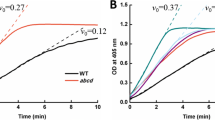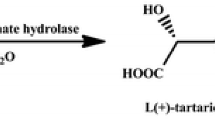Abstract
This study aimed to improve the thermostability of arylsulfatase from Pseudoalteromonas carrageenovora. A library of P. carrageenovora arylsulfatase mutants was constructed by introducing random mutagenesis using error-prone PCR. After screening, two mutants of H260L and D84A/H260L showed enhanced thermal stability than the wild-type predecessor (WT). Site-directed mutagenesis demonstrated that only amino acid residue at Position 260 plays an important role in the thermostability of P. carrageenovora arylsulfatase. Thermal inactivation analysis showed that the half-life (t1/2) values at 55°C for H260L, H260I, H260Q, H260F and H260R were 40.6, 48.4, 30.9, 29.1 and 34.5 min, respectively, while that of WT was 9.1 min. Structure modeling demonstrated that the additional hydrogen bonds and/or optimization of surface charge-charge interactions could be responsible for the increased thermostability imparted by H260L, H260I, H260Q, H260F and H260R.
Similar content being viewed by others
References
Akbulut N, Tuzlakoğlu Öztürk M, Pijning T, et al. 2013. Improved activity and thermostability of Bacillus pumilus lipase by directed evolution. Journal of Biotechnology, 164(1): 123–129, doi: 10.1016/j.jbiotec.2012.12.016
Arnott S, Fulmer A, Scott W E, et al. 1974. The agarose double helix and its function in agarosegel structure. Journal of Molecular Biology, 90(2): 269–284, doi: 10.1016/0022-2836(74)90372-6
Barbeyron T, Potin P, Richard C, et al. 1995. Arylsulphatase from Alteromonas carrageenovora. Microbiology, 141(11): 2897–2904, doi: 10.1099/13500872-141-11-2897
Ben Mabrouk S, Ayadi D Z, Ben Hlima H, et al. 2013. Thermostability improvement of maltogenic amylase MAUS149 by error prone PCR. Journal of Biotechnology, 168(4): 601–606, doi: 10.1016/j.jbiotec.2013.08.026
Blum S C, Lehmann J, Solomon D, et al. 2013. Sulfur forms in organic substrates affecting S mineralization in soil. Geoderma, 200–201: 156–164
Boersma Y L, Dröge M J, Quax W J. 2007. Selection strategies for improved biocatalysts. The FEBS Journal, 274(9): 2181–2195, doi: 10.1111/ejb.2007.274.issue-9
Bradford M M. 1976. A rapid and sensitive method for the quantitation of microgram quantities of protein utilizing the principle of protein-dye binding. Analytical Biochemistry, 72(1–2): 248–254
Cregut M, Rondags E. 2013. New insights in agar biorefinery with arylsulphatase activities. Process Biochemistry, 48(12): 1861–1871, doi: 10.1016/j.procbio.2013.09.020
Duckworth M, Yaphe W. 1971. The structure of agar: Part I. Fraction-ation of a complex mixture of polysaccharides. Carbohydrate Research, 16(1): 189–197, doi: 10.1016/S0008-6215(00)86113-3
Gao Chao, Jin Min, Yi Zhiwei, et al. 2015. Characterization of a recombinant thermostable arylsulfatase from deep-sea bacterium Flammeovirga pacifica. Journal of Microbiology and Biotechnology, 25(11): 1894–1901, doi: 10.4014/jmb.1504.04028
Guiseley K B. 1970. The relationship between methoxyl content and gelling temperature of agarose. Carbohydrate Research, 13(2): 247–256, doi: 10.1016/S0008-6215(00)80831-9
Guo Jing, Rao Zhiming, Yang Taowei, et al. 2015. Enhancement of the thermostability of Streptomyces kathirae SC-1 tyrosinase by rational design and empirical mutation. Enzyme and Microbial Technology, 77: 54–60, doi: 10.1016/j.enzmictec.2015.06.002
Henderson M J, Milazzo F H. 1979. Arylsulfatase in Salmonella typh-imurium: detection and influence of carbon source and tyram-ine on its synthesis. Journal of Bacteriology, 139(1): 80–87
Izumi K. 1970. A new method for fractionation of agar. Agricultural and Biological Chemistry, 34(1): 1739–1740
Kim D E, Kim K H, Bae Y J, et al. 2005. Purification and characterization of the recombinant arylsulfatase cloned from Pseudoal-teromonas carrageenovora. Protein Expression and Purification, 39(1): 107–115, doi: 10.1016/j.pep.2004.09.007
Kim J H, Byun D S, Godber J S, et al. 2004. Purification and characterization of arylsulfatase from Sphingomonas sp. AS6330. Applied Microbiology and Biotechnology, 63(5): 553–559, doi: 10.1007/s00253-003-1463-8
Kumar A, Singh S. 2013. Directed evolution: tailoring biocatalysts for industrial applications. Critical Reviews in Biotechnology, 33(4): 365–378, doi: 10.3109/07388551.2012.716810
Laskowski R A, MacArthur M W, Moss D S, et al. 1993. PROCHECK: a program to check the stereochemical quality of protein structures. Journal of Applied Crystallography, 26(2): 283–291, doi: 10.1107/S0021889892009944
Lee D G, Shin J G, Jeon M J, et al. 2013. Heterologous expression and characterization of a recombinant thermophilic arylsulfatase from Thermotoga maritima. Biotechnology and Bioprocess Engineering, 18(5): 897–902, doi: 10.1007/s12257-013-0094-x
Letunic I, Doerks T, Bork P. 2015. SMART: recent updates, new developments and status in 2015. Nucleic Acids Research, 43(D1): D257–D260, doi: 10.1093/nar/gku949
Lim J M, Jang Y H, Kim H R, et al. 2004. Overexpression of arylsulfatase in E. coli and its application to desulfatation of agar. Journal of Microbiology and Biotechnology, 14(4): 777–782
Lin Ling, Fu Chenggen, Huang Weiqian. 2016. Improving the activity of the endoglucanase, Cel8M from Escherichia coli by error-prone PCR. Enzyme and Microbial Technology, 86: 52–58, doi: 10.1016/j.enzmictec.2016.01.011
Marino T, Russo N, Toscano M. 2013. Catalytic mechanism of the arylsulfatase promiscuous enzyme from Pseudomonas aeru-ginosa. Chemistry-A European Journal, 19(6): 2185–2192, doi: 10.1002/chem.v19.6
Miech C, Dierks T, Selmer T, et al. 1998. Arylsulfatase from Klebsiella pneumoniae carries a formylglycine generated from a serine. The Journal of Biological Chemistry, 273(9): 4835–4837, doi: 10.1074/jbc.273.9.4835
Mohammadi M, Sepehrizadeh Z, Ebrahim-Habibi A, et al. 2016. Enhancing activity and thermostability of lipase A from Serratia marcescens by site-directed mutagenesis. Enzyme and Microbial Technology, 93–94: 18–28
Murooka Y, Yim M H, Harada T. 1980. Formation and purification of Serratia marcescens arylsulfatase. Applied and Environmental Microbiology, 39(4): 812–817
Niu Rungui, Jing Hua, Chen Zhao, et al. 2012. Differentiating malignant colorectal tumor patients from benign colorectal tumor patients by assaying morning urinary arylsulfatase activity. Asia-Pacific Journal of Clinical Oncology, 8(4): 362–367, doi: 10.1111/ajco.2012.8.issue-4
Okamura H, Yamada T, Murooka Y, et al. 2008. Purification and properties of arylsulfatase of Klebsiella aerogenes identity of the enzymes formed by non-repressed and de-repressed synthesis. Agricultural and Biological Chemistry, 40(10): 2071–2076
Schweiker K L, Makhatadze G I. 2009. Protein stabilization by the rational design of surface charge-charge interactions. In: Shriver J, ed. Protein Structure, Stability, and Interactions. New York: Humana Press, 490: 261–283
Schweiker K L, Zarrine-Afsar A, Davidson A R, et al. 2007. Computational design of the Fyn SH3 domain with increased stability through optimization of surface charge-charge interactions. Protein Science, 16(12): 2694–2702, doi: 10.1110/(ISSN)1469-896X
Stressler T, Leisibach D, Lutz-Wahl S, et al. 2016a. Homologous expression and biochemical characterization of the arylsulfatase from Kluyveromyces lactis and its relevance in milk processing. Applied Microbiology and Biotechnology, 100(12): 5401–5014, doi: 10.1007/s00253-016-7366-2
Stressler T, Seitl I, Kuhn A, et al. 2016b. Detection, production, and application of microbial arylsulfatases. Applied Microbiology and Biotechnology, 100(21): 9053–9067, doi: 10.1007/s00253-016-7838-4
Tu Tao, Luo Huiying, Meng Kun, et al. 2015. Improvement in thermo-stability of an Achaetomium sp. strain Xz8 endopolygalactur-onase via the optimization of charge-charge interactions. Applied and Environmental Microbiology, 81(19): 6938–6944, doi: 10.1128/AEM.01363-15
Vieira D S, Degrève L. 2009. An insight into the thermostability of a pair of xylanases: the role of hydrogen bonds. Molecular Physics, 107(1): 59–69, doi: 10.1080/00268970902717959
Vogt G, Woell S, Argos P. 1997. Protein thermal stability, hydrogen bonds, and ion pairs. Journal of Molecular Biology, 269(4): 631–643, doi: 10.1006/jmbi.1997.1042
Wang Xueyan, Duan Delin, Xu Jiachao, et al. 2015. Characterization of a novel alkaline arylsulfatase from Marinomonas sp. FW-1 and its application in the desulfation of red seaweed agar. Journal of Industrial Microbiology & Biotechnology, 42(10): 1353–1362, doi: 10.1007/s10295-015-1625-6
Webb B, Webb B, Marti-Renom M A, et al. 2007. Comparative protein structure modeling using Modeller. Current Protocols in Protein Science, 50(1): 2.9.1–2.9.31, doi: 10.1002/0471140864. 2007.50.issue-1
Zhang Lujia, Tang Xiaomang, Cui Dongbing, et al. 2014. A method to rationally increase protein stability based on the charge-charge interaction, with application to lipase LipK107. Protein Science, 23(1): 110–116, doi: 10.1002/pro.2388
Zhou Cheng, Xue Yanfen, Ma Yanhe. 2015. Evaluation and directed evolution for thermostability improvement of a GH 13 thermostable α-glucosidase from Thermus thermophilus TC11. BMC Biotechnology, 15: 97, doi: 10.1186/s12896-015-0197-x
Zhu Yanbing, Zheng Wenguang, Ni Hui, et al. 2015. Molecular cloning and characterization of a new and highly thermostable esterase from Geobacillus sp. JM6. Journal of Basic Microbiology, 55(10): 1219–1231, doi: 10.1002/jobm.v55.10
Author information
Authors and Affiliations
Corresponding author
Additional information
Foundation item: The National Natural Science Foundation of China under contract No. 31401632; the Program for New Century Excellent Talents in Fujian Province University, China under contract No. B15139.
Rights and permissions
About this article
Cite this article
Zhu, Y., Yin, X., Liu, H. et al. Substitution of His260 residue alters the thermostability of Pseudoalteromonas carrageenovora arylsulfatase. Acta Oceanol. Sin. 38, 75–82 (2019). https://doi.org/10.1007/s13131-019-1356-z
Received:
Accepted:
Published:
Issue Date:
DOI: https://doi.org/10.1007/s13131-019-1356-z




